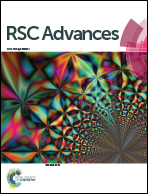High piezoelectricity in low-temperature sintering potassium–sodium niobate-based lead-free ceramics
Abstract
Here we have realized three goals in a new potassium–sodium niobate material using CuO as sintering aid, such as low temperature sintering, the suppression in the loss of alkali metals, and attaining a high d33. Low-temperature sintered 0.96(K0.46Na0.54)Nb0.95Sb0.05O3–0.04Bi0.5(Na0.82K0.18)0.5ZrO3 ceramics were made conducting by adding CuO using an ordinary ceramic fabrication technique. The sintering temperatures drop from 1095 °C to 950 °C when the CuO content is increased from 0 to 2.5 wt%, and the K and Na loss could be also prevented under a low processing temperature. In addition, the ceramics undergo a phase transition with increasing CuO content, such as from a rhombohedral–tetragonal phase coexistence to the mixture of both rhombohedral–orthorhombic and orthorhombic–tetragonal phase boundaries. The inhomogeneous Cu2+ distributions become more obvious as the CuO content rises, i.e., the excess Cu2+ aggregates at the small grains region for a low CuO content (x ≤ 1.5), and at the small and large grains zones for x = 2.5. The dielectric constant gradually decreases as the CuO increases, and the dielectric loss is lowered by adding CuO content. A well polarization vs. electric field (P–E) loop is seen in the ceramics with x ≤ 2.5, and those with x = 2.5 possess a high d33 of 310 pC N−1 even if the sintering temperatures drop down to 950 °C. As a result, it is an efficient way to promote the piezoelectricity of copper oxide-modified alkaline niobate ceramics using a low-temperature sintering technique.


 Please wait while we load your content...
Please wait while we load your content...